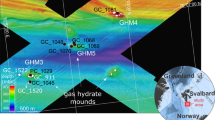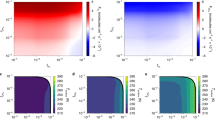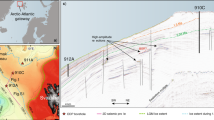Abstract
Once thought to be devoid of life, the ice-covered parts of Antarctica are now known to be a reservoir of metabolically active microbial cells and organic carbon1. The potential for methanogenic archaea to support the degradation of organic carbon to methane beneath the ice, however, has not yet been evaluated. Large sedimentary basins containing marine sequences up to 14 kilometres thick2 and an estimated 21,000 petagrams (1 Pg equals 1015 g) of organic carbon are buried beneath the Antarctic Ice Sheet. No data exist for rates of methanogenesis in sub-Antarctic marine sediments. Here we present experimental data from other subglacial environments that demonstrate the potential for overridden organic matter beneath glacial systems to produce methane. We also numerically simulate the accumulation of methane in Antarctic sedimentary basins using an established one-dimensional hydrate model3 and show that pressure/temperature conditions favour methane hydrate formation down to sediment depths of about 300 metres in West Antarctica and 700 metres in East Antarctica. Our results demonstrate the potential for methane hydrate accumulation in Antarctic sedimentary basins, where the total inventory depends on rates of organic carbon degradation and conditions at the ice-sheet bed. We calculate that the sub-Antarctic hydrate inventory could be of the same order of magnitude as that of recent estimates made for Arctic permafrost. Our findings suggest that the Antarctic Ice Sheet may be a neglected but important component of the global methane budget, with the potential to act as a positive feedback on climate warming during ice-sheet wastage.
This is a preview of subscription content, access via your institution
Access options
Subscribe to this journal
Receive 51 print issues and online access
$199.00 per year
only $3.90 per issue
Buy this article
- Purchase on Springer Link
- Instant access to full article PDF
Prices may be subject to local taxes which are calculated during checkout




Similar content being viewed by others
References
Priscu, J. et al. in Polar Lakes and Rivers (eds Vincent, W. F. & Laybourn-Parry, J. ) 320 (Oxford University Press, 2009)
Ferraccioli, F., Armadillo, E., Jordan, T., Bozzo, E. & Corr, H. Aeromagnetic exploration over the East Antarctic Ice Sheet: a new view of the Wilkes Subglacial Basin. Tectonophysics 478, 62–77 (2009)
Davie, M. K. & Buffett, B. A. A numerical model for the formation of gas hydrate below the seafloor. J. Geophys. Res. 106, 497–514 (2001)
Wellsbury, P., Mather, I. & Parkes, R. J. Geomicrobiology of deep, low organic carbon sediments in the Woodlark Basin, Pacific Ocean. FEMS Microbiol. Ecol. 42, 59–70 (2002)
Cragg, B. A. et al. Bacterial populations and processes in sediments containing gas hydrates (ODP Leg 146: Cascadia Margin). Earth Planet. Sci. Lett. 139, 497–507 (1996)
Colwell, F. S. et al. Estimates of biogenic methane production rates in deep marine sediments at Hydrate Ridge, Cascadia margin. Appl. Environ. Microb. 74, 3444–3452 (2008)
Parkes, R. J. et al. Bacterial biomass and activity in deep sediment layers from the Peru margin. Phil. Trans. R. Soc. Lond. A 331, 139–153 (1990)
Yoshioka, H., Sakata, S., Cragg, B. A., Parkes, R. J. & Fujii, T. Microbial methane production rates in gas hydrate-bearing sediments from the eastern Nankai Trough, off central Japan. Geochem. J. 43, 315–321 (2009)
Kotsyurbenko, O. R. et al. Acetoclastic and hydrogenotrophic methane production and methanogenic populations in an acidic West-Siberian peat bog. Environ. Microbiol. 6, 1159–1173 (2004)
Franzmann, P. D., Roberts, N. J., Mancuso, C. A., Burton, H. R. & McMeekin, T. A. Methane production in meromictic Ace Lake, Antarctica. Hydrobiologia 210, 191–201 (1991)
Smith, R., Miller, L. & Howes, B. The geochemistry of methane in Lake Fryxell, an amictic, permanently ice-covered, antarctic lake. Biogeochemistry 21, 95–115 (1993)
Ellis-Evans, J. C. Methane in maritime Antarctic freshwater lakes. Polar Biol. 3, 63–71 (1984)
Archer, D. Methane hydrate stability and anthropogenic climate change. Biogeosciences 4, 521–544 (2007)
Wadham, J. L., Tranter, M., Tulaczyk, S. & Sharp, M. Subglacial methanogenesis: a potential climatic amplifier? Glob. Biogeochem. Cycles 22, GB2021 (2008)
Lanoil, B. et al. Bacteria beneath the West Antarctic Ice Sheet. Environ. Microbiol. 11, 609–615 (2009)
Boyd, E. S., Skidmore, M., Mitchell, A. C., Bakermans, C. & Peters, J. W. Methanogenesis in subglacial sediments. Environ. Microbiol. Rep. 2, 685–692 (2010)
Pattyn, F. Antarctic subglacial conditions inferred from a hybrid ice sheet/ice stream model. Earth Planet. Sci. Lett. 295, 451–461 (2010)
Maule, C. F., Purucker, M. E., Olsen, N. & Mosegaard, K. Heat flux anomalies in Antarctica revealed by satellite magnetic data. Science 309, 464–467 (2005)
Claypool, G. F., Lorensen, T. D. & Johnson, C. A. Authigenic carbonates, methane generation, and oxidation in continental rise and shelf sediments, ODP leg 188, sites 1165 and 1166, offshore Antarctica (Prydz Bay). Proc. ODP Sci. Results 188, 1–15 (2004)
Tarnocai, C. et al. Soil organic carbon pools in the northern circumpolar permafrost region. Glob. Biogeochem. Cycles 23, GB2023 (2009)
Houghton, R. A. Balancing the global carbon budget. Annu. Rev. Earth Planet. Sci. 35, 313–347 (2007)
Meyers, P. A. & Ishiwatari, R. Lacustrine organic geochemistry—an overview of indicators of organic matter sources and diagenesis in lake sediments. Org. Geochem. 20, 867–900 (1993)
Boudreau, B. P. & Ruddick, B. R. On a reactive continuum representation of organic-matter diagenesis. Am. J. Sci. 291, 507–538 (1991)
Reeburgh, W. S., Whalen, S. C. & Alperin, M. J. In Microbial Growth on C1 Compounds (eds Murrell, J. C. & Kelly, D. P. ) 1–14 (Intercept Ltd, 1993).
Etiope, G. & Klusman, R. W. Geologic emissions of methane to the atmosphere. Chemosphere 49, 777–789 (2002)
Torres, M. E. et al. Fluid and chemical fluxes in and out of sediments hosting methane hydrate deposits on Hydrate Ridge, OR. I: Hydrological provinces. Earth Planet. Sci. Lett. 201, 525–540 (2002)
Wallmann, K., Drews, M., Aloisi, G. & Bohrmann, G. Methane discharge into the Black Sea and the global ocean via fluid flow through submarine mud volcanoes. Earth Planet. Sci. Lett. 248, 545–560 (2006)
Boswell, R. & Collett, T. S. Current perspectives on gas hydrate resources. Energy Environ. Sci. 4, 1206–1215 (2011)
Pollard, D. & DeConto, R. M. Modelling West Antarctic ice sheet growth and collapse through the past five million years. Nature 458, 329–332 (2009)
Dyke, A. S., Prest, V. K. & Narraway, J. D. in Map/Geological Survey of Canada 1702A (Geological Survey of Canada, 1987)
Dickens, G. R., Paull, C. K. & Wallace, P. Direct measurement of in situ methane quantities in a large gas-hydrate reservoir. Nature 385, 426–428 (1997)
Barker, P. F., Camerlenghi, A. & Acton, G. D. Leg 178 Summary. Proc ODP Init. Rep. 178, 60 (1999)
Acknowledgements
This research was funded by the Natural Environment Research Council (UK—NERC grant NE/E004016/1) and the National Science Foundation WISSARD project (NSF-AISS 0839142). Support to J.L.W. was also provided by the Leverhulme Trust via a Phillip Leverhulme award and to S.A. by the Netherlands Organisation for Scientific Research (NWO). We acknowledge NSERC and Antarctica New Zealand for financial and logistic support for sampling in Antarctica and the Polar Continental Shelf Project for financial and logistic support for sampling in Arctic Canada. We thank S. Fitzsimons for assistance with sampling in Antarctica. A.D. was funded by an NSERC Undergraduate Student Research Award. This research used data provided by the Ocean Drilling Program. The Ocean Drilling Program is sponsored by the US National Science Foundation and participating countries under the management of the Joint Oceanographic Institutions, Inc. We thank C. Ruppel for comments on this manuscript.
Author information
Authors and Affiliations
Contributions
J.L.W. wrote the paper and directed the work, and led the sample collection in Greenland. S.A. did the numerical modelling and contributed to manuscript preparation. S.T. assisted with the modelling and contributed to manuscript preparation. M.S. contributed to the writing of the manuscript and did experimental work. J.T. did the initial design of incubation experiments, laboratory analysis of incubation experiments, and sample collection. G.P.L. performed laboratory analysis of the incubation experiments, and did sample collection. E.L. performed laboratory analysis of incubation experiments. A.D. performed laboratory analysis of the incubation experiments. M.T. assisted with the manuscript and modelling calculations. M.J.S. added input to the incubation experiments, and did sample collection of Antarctic subglacial material. A.M.A. assisted with writing the manuscript and advised upon incubation experiments. A.R. assisted with manuscript preparation and numerical modelling. C.B. assisted with the laboratory analysis of the incubation experiments.
Corresponding author
Ethics declarations
Competing interests
The authors declare no competing financial interests.
Supplementary information
Supplementary Information
This file contains Supplementary Text, Supplementary Tables 1-6, Supplementary Figures 1-6 and Supplementary References. (PDF 1143 kb)
Rights and permissions
About this article
Cite this article
Wadham, J., Arndt, S., Tulaczyk, S. et al. Potential methane reservoirs beneath Antarctica. Nature 488, 633–637 (2012). https://doi.org/10.1038/nature11374
Received:
Accepted:
Published:
Issue Date:
DOI: https://doi.org/10.1038/nature11374
This article is cited by
-
Methylotrophic Communities Associated with a Greenland Ice Sheet Methane Release Hotspot
Microbial Ecology (2023)
-
Subglacial erosion has the potential to sustain microbial processes in Subglacial Lake Whillans, Antarctica
Communications Earth & Environment (2021)
-
Evaluation and re-understanding of the global natural gas hydrate resources
Petroleum Science (2021)
-
Greenland melt drives continuous export of methane from the ice-sheet bed
Nature (2019)
-
Ice sheets matter for the global carbon cycle
Nature Communications (2019)
Comments
By submitting a comment you agree to abide by our Terms and Community Guidelines. If you find something abusive or that does not comply with our terms or guidelines please flag it as inappropriate.



